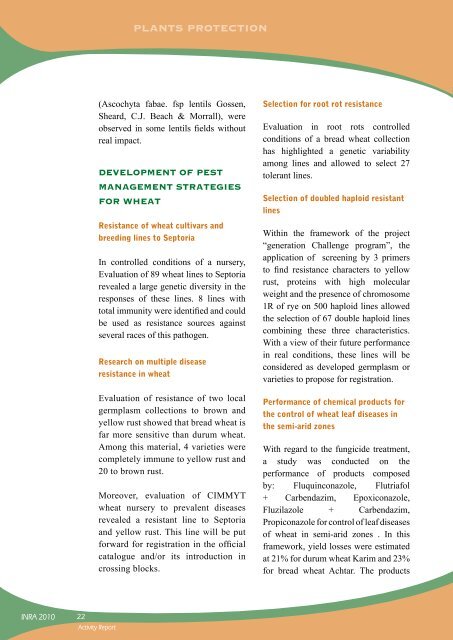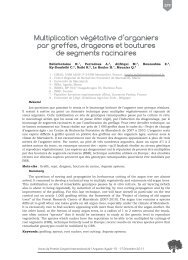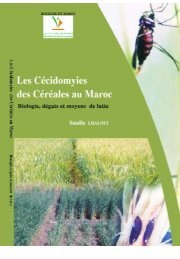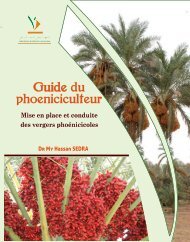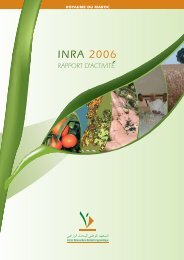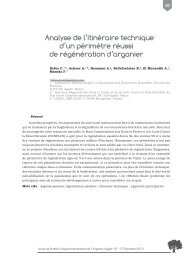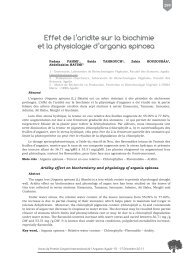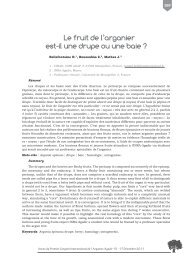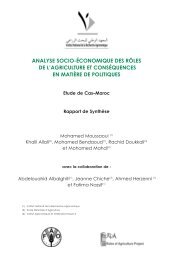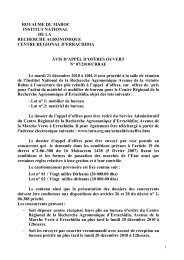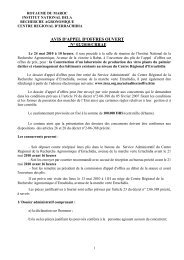varieties creation and conservation of plant genetic resources
varieties creation and conservation of plant genetic resources
varieties creation and conservation of plant genetic resources
Create successful ePaper yourself
Turn your PDF publications into a flip-book with our unique Google optimized e-Paper software.
INRA 2010<br />
22<br />
Activity Report<br />
PLANTS PROTECTION<br />
(Ascochyta fabae. fsp lentils Gossen,<br />
Sheard, C.J. Beach & Morrall), were<br />
observed in some lentils fields without<br />
real impact.<br />
DEVELOPMENT OF PEST<br />
MANAGEMENT STRATEGIES<br />
FOR WHEAT<br />
Resistance <strong>of</strong> wheat cultivars <strong>and</strong><br />
breeding lines to Septoria<br />
In controlled conditions <strong>of</strong> a nursery,<br />
Evaluation <strong>of</strong> 89 wheat lines to Septoria<br />
revealed a large <strong>genetic</strong> diversity in the<br />
responses <strong>of</strong> these lines. 8 lines with<br />
total immunity were identified <strong>and</strong> could<br />
be used as resistance sources against<br />
several races <strong>of</strong> this pathogen.<br />
Research on multiple disease<br />
resistance in wheat<br />
Evaluation <strong>of</strong> resistance <strong>of</strong> two local<br />
germplasm collections to brown <strong>and</strong><br />
yellow rust showed that bread wheat is<br />
far more sensitive than durum wheat.<br />
Among this material, 4 <strong>varieties</strong> were<br />
completely immune to yellow rust <strong>and</strong><br />
20 to brown rust.<br />
Moreover, evaluation <strong>of</strong> CIMMYT<br />
wheat nursery to prevalent diseases<br />
revealed a resistant line to Septoria<br />
<strong>and</strong> yellow rust. This line will be put<br />
forward for registration in the <strong>of</strong>ficial<br />
catalogue <strong>and</strong>/or its introduction in<br />
crossing blocks.<br />
Selection for root rot resistance<br />
Evaluation in root rots controlled<br />
conditions <strong>of</strong> a bread wheat collection<br />
has highlighted a <strong>genetic</strong> variability<br />
among lines <strong>and</strong> allowed to select 27<br />
tolerant lines.<br />
Selection <strong>of</strong> doubled haploid resistant<br />
lines<br />
Within the framework <strong>of</strong> the project<br />
“generation Challenge program”, the<br />
application <strong>of</strong> screening by 3 primers<br />
to find resistance characters to yellow<br />
rust, proteins with high molecular<br />
weight <strong>and</strong> the presence <strong>of</strong> chromosome<br />
1R <strong>of</strong> rye on 500 haploid lines allowed<br />
the selection <strong>of</strong> 67 double haploid lines<br />
combining these three characteristics.<br />
With a view <strong>of</strong> their future performance<br />
in real conditions, these lines will be<br />
considered as developed germplasm or<br />
<strong>varieties</strong> to propose for registration.<br />
Performance <strong>of</strong> chemical products for<br />
the control <strong>of</strong> wheat leaf diseases in<br />
the semi-arid zones<br />
With regard to the fungicide treatment,<br />
a study was conducted on the<br />
performance <strong>of</strong> products composed<br />
by: Fluquinconazole, Flutriafol<br />
+ Carbendazim, Epoxiconazole,<br />
Fluzilazole + Carbendazim,<br />
Propiconazole for control <strong>of</strong> leaf diseases<br />
<strong>of</strong> wheat in semi-arid zones . In this<br />
framework, yield losses were estimated<br />
at 21% for durum wheat Karim <strong>and</strong> 23%<br />
for bread wheat Achtar. The products


